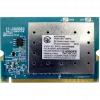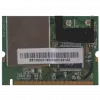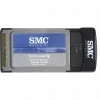Mini PCI was added to PCI version 2.2 for use in laptops, it uses a 32-bit, 33-MHz bus with powered connections (3.3 V only; 5V is limited to 100mA) and support for bus mastering and DMA. The standard size for Mini PCI cards is approximately 1/4 of their full-sized counterparts. As there is limited external access to the card compared to desktop PCI cards, there are limitations on the functions they may perform.
MiniPCI and MiniPCI Express cards in comparison
Many Mini PCI devices were developed such as Wi-Fi, Fast Ethernet, Bluetooth, modems (often Winmodems), sound cards, cryptographic accelerators, SCSI, IDE/ATA, SATA controllers and combination cards. Mini PCI cards can be used with regular PCI-equipped hardware, using Mini PCI-to-PCI converters. Mini PCI has been superseded by PCI Express Mini Card.
Technical details of Mini PCI
Mini PCI cards have a 2 W maximum power consumption, which also limits the functionality that can be implemented in this form factor. They also are required to support the CLKRUN# PCI signal used to start and stop the PCI clock for power management purposes.
There are three card form factors: Type I, Type II, and Type III cards. The card connector used for each type include: Type I and II use a 100-pin stacking connector, while Type III uses a 124-pin edge connector, i.e. the connector for Types I and II differs from that for Type III, where the connector is on the edge of a card, like with a SO-DIMM. The additional 24 pins provide the extra signals required to route I/O back through the system connector (audio, AC-Link, LAN, phone-line interface). Type II cards have RJ11 and RJ45 mounted connectors. These cards must be located at the edge of the computer or docking station so that the RJ11 and RJ45 ports can be mounted for external access.











